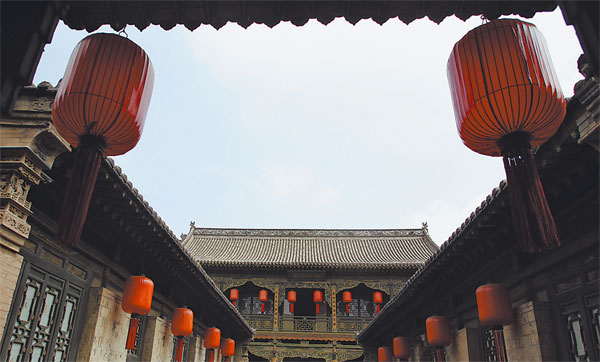Lesser-known Shanxi province is home to world-renowned sites
|
Qiao's Grand Courtyard is an example of the traditional residential buildings of North China. Zhang Wei / China Daily |
Most foreign tourists who come to China are familiar with Shaanxi province, where the Terracotta Army sculptures depicting the soldiers of Qin Shi Huang, the first Emperor of China, are located. But few know about Shanxi, a province bordering its more famous neighbor. Indeed, the similar names, Shaanxi and Shanxi, lead to confusion among foreign tourists.
Shanxi, however, has as much to offer as its neighboring province.
Coal mining has dominated the province over the years and still does, but the local authorities are focusing on attracting more visitors, both from within China and overseas.
Shanxi is home to numerous cultural heritage items and serves as a hub for ancient Chinese culture and picturesque landscapes.
Qiao's Grand Courtyard, located in Qiaojiabao village in Qixian county, is an example of the traditional residential buildings of North China. The ancient city of Pingyao is referred to as the "Chinese Wall Street", as it was home to many banking institutions from ancient times and also has more than 300 historic relics and buildings as well as 4,000 well-preserved homes from the Ming and Qing Dynasties (1368-1911).
If one wants to visit temples and pagodas, Wutai Mountain, the Hanging Monastery and Yungang Grottoes are the places to go.
Wutai Mountain has temples in various architectural styles that offer sculptures, stone carvings, murals and calligraphy works. It is home to more than 30,000 sculptures of Buddhas of different religions and cultures, including Confucianism, Taoism and local religions. The Hanging Monastery clings to Hengshan Mountain; its structure built into the cliff 75 meters above the ground. Further away, not far from the city of Datong are the Yungang Grottoes, which in 2001 were listed as a UNESCO World Heritage site. It has 51 main grottoes and more than 5,100 Buddha statues, with heights ranging from several centimeters to 17 meters.
Li Jing is a teacher at Taiyuan Tourism College who has trained future tour guides for about nine years. Li also accompanies foreign visitors who come to the province. She said the number of tourists has increased over the years.
"Mostly we have foreign tourists from Europe and less from the United States. In Shanxi, tour guides are provided in English, German and French," she said.
Li said the tourism infrastructure in Shanxi has improved. Previously, she said, there were no expressways to travel on to the remote but interesting places in Shanxi province; service at hotels was poor and there were very few English-speaking tour guides.
"The tourism industry in Shanxi has seen a dramatic change in recent years. The traveling connections now are better. Before it took eight hours to travel from Taiyuan to Wutai Mountain, but now the time has been reduced dramatically," she said.
Sun Zhuoyang is from Taiyuan, the capital city of Shanxi province. He is studying finance in Toronto, Canada, but during the summer holidays, returns to his hometown to volunteer in the tourism industry.
"Shanxi's history, cuisine and green spaces are great features to attract foreign visitors to this province," Sun said.
Bright Mhango, a Malawian blogger, had never heard of Shanxi because, he said, it was always overshadowed by Xi'an, famous for its Terracotta Army.
"Shanxi has got it. It can compete with Egypt or Peru, and also Beijing, if it aggressively pursues a certain media line and marketing philosophy. More people need to know about Shanxi," Mhango said.
Holger Briel, a German professor at the Xi'an Jiaotong-Liverpool University in Suzhou, said he was impressed with the sites, tourism infrastructure, including transportation, accommodation and English descriptions at tourist attractions during his visit to Shanxi.
"As the tourism industry in Shanxi is booming, in the future, market segmentation might be a way forward by addressing different tourists' needs - backpackers, the luxury segment, families, eco-tourism and so on," Briel said.
Yvonne Horst, a Dutch travel blogger on her second visit to Shanxi, said more information in English should be available for foreign tourists. However, she said foreign tourists, especially solo travelers, shouldn't let language barriers or cultural differences discourage them from visiting Shanxi or anywhere else in China.
"Get a dictionary, books that help you communicate without saying a word, with point-to pictures and phrases, be ready for adventure and remember that Chinese are friendly and helpful, proud of their cultural heritage and willing to share it with foreigners," Horst said.
Shanxi is focusing on tourism as the new engine for the province's economic development. Revenues generated by the industry during the first quarter of 2015 reached 46 billion yuan ($7.4 billion) and the number of high-level scenic spots has been increasing.
Ma Bin, an official with the Datong publicity department, said more needs to be done to improve the tourism industry.
"There is a tourism strategy that we have been working on, which will be completed by the end of the year. It includes the improvement of the tourist industry in Datong and Shanxi province," Ma said.
The author is a freelance writer from Albania.
ardi.pulaj@gmail.com



















